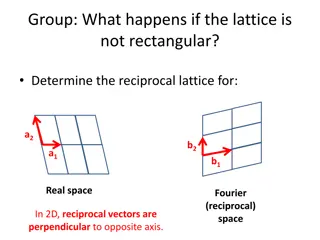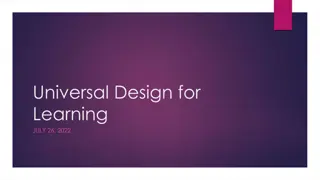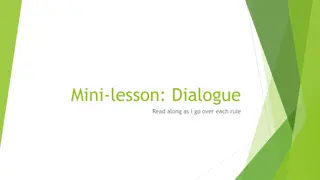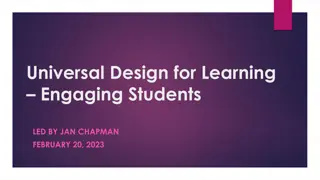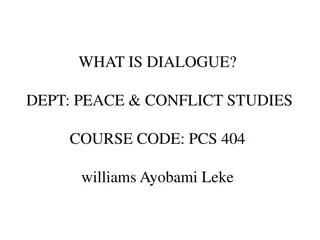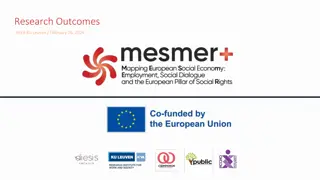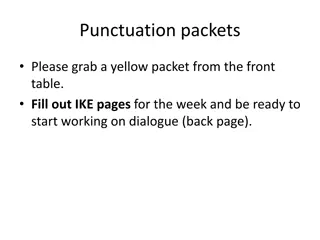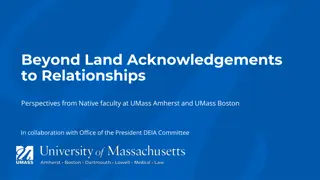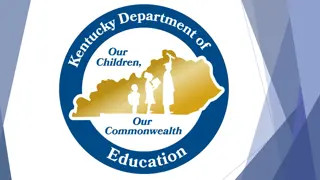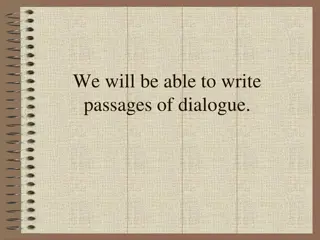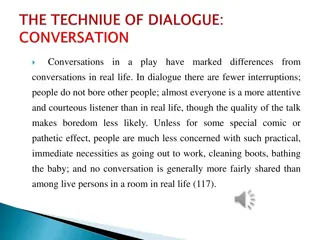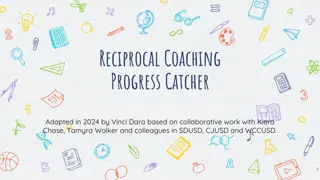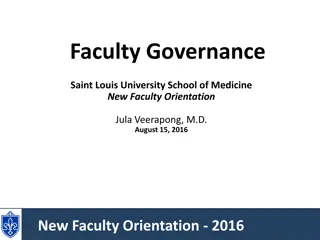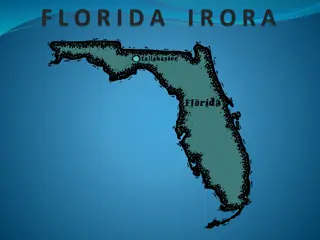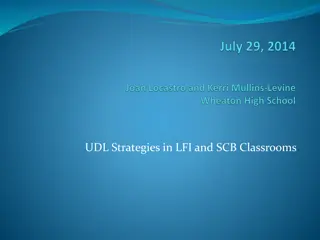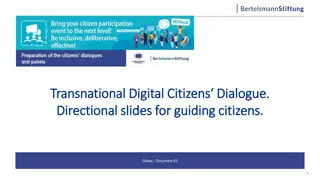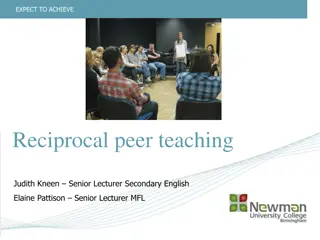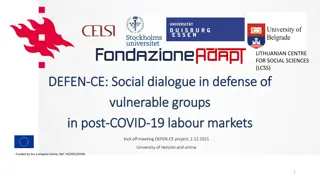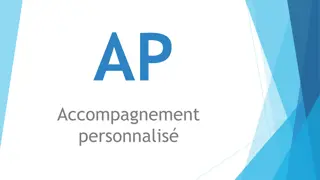Reciprocal Dialogue in UDL Implementation: Faculty-Student Perspectives
Exploring opportunities for dialogue between faculty and students on Universal Design for Learning (UDL) at Thompson Rivers University in Canada. Dr. Frederic Fovet leads discussions on UDL implementation, inclusive design, and student agency. Objectives include examining UDL developments in higher education, focusing on student voice, discussing project goals, and scaling up dialogue to the campus level amid the growth of UDL interest post-COVID. Challenges and best practices are addressed to foster effective faculty-student collaboration.
Download Presentation

Please find below an Image/Link to download the presentation.
The content on the website is provided AS IS for your information and personal use only. It may not be sold, licensed, or shared on other websites without obtaining consent from the author.If you encounter any issues during the download, it is possible that the publisher has removed the file from their server.
You are allowed to download the files provided on this website for personal or commercial use, subject to the condition that they are used lawfully. All files are the property of their respective owners.
The content on the website is provided AS IS for your information and personal use only. It may not be sold, licensed, or shared on other websites without obtaining consent from the author.
E N D
Presentation Transcript
ADCET Workshop: Exploring opportunities for reciprocal dialogue between faculty and students around UDL implementation and inclusive design Dr. Frederic Fovet School of Education, Faculty of Education and Social Work Thompson Rivers University, BC, Canada August 22nd, 2024
Land Acknowledgement Thompson Rivers University campuses are on the traditional lands of the Tk'eml ps te Secw pemc (Kamloops campus) and the T exelc (Williams Lake campus) within Secw pemc'ulucw, the traditional and unceded territory of the Secw pemc. The region TRU serves also extends into the territories of the St t imc, Nlaka pamux, T ilhqot'in, Nuxalk, and Dakelh
Personal introduction Frederic is an Assistant Professor in the School of Education at Thompson Rivers University in BC, Canada The focus of his research is inclusion, UDL, accessibility, and social justice in teaching and learning He is a UDL and inclusion consultant both domestically and internationally supporting tertiary organizations and K-12 schools and school boards. https://kamino.tru.ca/experts/home/ main/bio.php?id=Ffovet
Objectives of the session Scan the current developments in UDL implementation across the tertiary sector in the Global North and explore the focus on student voice/ agency Discuss the objectives of the project and its methodological stance as a backdrop to this reflection Examine the concept of faculty-student dialogue around UDL at the micro-level of the classroom Shift the reflection on faculty-student dialogue around UDL to the faculty/ departmental level Scale up the reflection on faculty-student dialogue around UDL to the campus wide/ systemic dimension Examine best practices to include students in campus reflection on UDL Acknowledge inherent challenges in creating student-faculty dialogue around UDL
Context: Acknowledging the rapid growth of UDL and the tension around student agency Much momentum for UDL in higher education over the last 15 years. Broadly across the Global North, there has been growth in interest for UDL and a plethora of sporadic pockets of UDL development The COVID pandemic has been significant in broadening faculty interest in UDL. There is wider receptiveness that instructors are designers However, there is also concern over the lack of sustained interest in the lessons learnt during the pandemic. Return to the old normal ? There has been a widening of the context within which UDL is emerging: further education, vocational training and trades education, labs, experiential learning contexts, graduate supervisory relationship, field placements, etc.
Some UDL strategies for interaction Use the Chat throughout this workshop and a moderator will bring questions to my attention. There will be two Menti activities. Please visit Menti.com on another screen or device when prompted. You can also maintain more substantial conversations with me through a Padlet: https://edswgrad.padlet.org/ffovet1/adcet-workshop-exploring-opportunities-for- reciprocal-dialog-swbvy6p4j493st1a I will interact on it immediately after the workshop and through the week You can interact about the workshop and ask questions through social media: LinkedIn, X, Bluesky You can email me if you have more specific questions or want to keep your discussion private
Context: Acknowledging the rapid growth of UDL and the tension around student agency However there remains some strategic uncertainty as to how to grow this momentum systemically across institutions. How do we attain sustainable development in this area? Understanding and awareness among advocates of UDL that its implementation can take multiple forms and cover a huge array of practices. How do we prioritize areas of change/ implementation? Literature on student agency/ voice is slim: is the UX perspective even in synch with that of the current faculty advocates and adopters? The study which serves as a basis for this reflection was seeking to see what degree of synchronicity existed between student and faculty advocates in their vision of sustainable UDL development and areas that stood out as priorities in UDL systemic growth.
Interactive snapshot We will use Menti to gauge the perceptions of the room. Please go to Menti.com on another screen/ device. I will give you a code to access a poll. How successful do you feel we are currently as a field in taking into account student/ voice and agency and its role in UDL integration/ implementation: Very successful Moderately successful Starting to tackle Behind and not catching up Ignoring this so far
A literature overview: striking paucity of work around student voice and agency The literature evidences a paucity of literature on student voice and agency within the UDL momentum (Fovet, 2018; Lubicz-Nawrocka, 2022). There are structural issues with tertiary that make this very challenging to develop (siloing of departments and services, power dynamics that downplay student voice, quick turnover of student population, complexity of bureaucratic processes that are challenging for students to master, heavy load of student advocates who carry out their role as volunteers, precarious living conditions of many students in tertiary/ pyramids of needs perspective, etc). Faculties and departments have few authentic avenues for UX feedback on course design. Discourse around course design is a loaded discussion that creates uneasiness even with faculty, service providers, or instructional designers (Reference to paper on MH and design)
A literature overview: striking paucity of work around student voice and agency (contd.) Institutions themselves are large, complex and multilayered and this offers few opportunities for authentic dialogue between student body and faculty as a whole (versus at class level). The ecology of tertiary is a rich mechanism of perpetuation of existing power dynamics, focus on resistance to change, and preservation of control/ power. There is also an overarching and increasing commitment to neoliberalism in education which embeds market considerations into processes and moves the field away from transformative and participatory philosophies. Diverse students are the primary victim/ casualty of this proves of marketisation.
Some background on the study which serves as a canvas for this reflection Create an institutional UDL CoP, in parallel with a student discussion circle on UDL Carry out semi-directive interviews with faculty and students already involved with some aspects of UDL development/ promotion Wrap up with a student-faculty focus group to document the extent to which dialogue was possible around UDL priorities within T&L. Deeply grounded in action-research tradition as the aim was to (i) create lasting frameworks that outlast the study itself, and (ii) empower students and amplify their voice within the UDL literature/ on the campus in question.
Mentiinterlude: First degree of student involvement in UDL growth Most faculty pride themselves on listening to student feedback. To what degree do you feel student feedback (anonymous or not) is truthful when it comes to accessibility? Extremely truthful Mostly truthful Somewhat truthful Not candid Very cautious
First degree of student involvement in UDL growth: the microsystem Study was expecting to see gaps between faculty and student perspective on priorities within UDL growth and development. Divergence does exist in this area though perhaps not as marked as one might predict Divergence is not so much about individual UDL priorities but more about communication, sharing of perspective, and the very processes of consensus A superficial/ generic assurance all UDL advocates are student centered. But is it that simple/ straight forward? A growing dilemma as to whether instructors can truly envisage all barriers students might be experiencing through an inclusive design reflection alone
First degree of student involvement in UDL growth: the microsystem (contd.) Seems pressing for any faculty to make actual contact with the UX and the student experience Some candid and truthful unease as to the degree to which experiences about UX in courses can be shared by learners Very tangible awareness on both sides of the fence of power dynamics that make any dialogue about the design of a course very challenging Students report having very specific feedback to offer but few opportunities to do so with ease and without fear of etiquette/ power concerns Added complexity of cultural dimensions behind this hesitation for many international students.
The second degree of student agency: Departmental and faculty scale The study findings highlight the degree to which formal mechanism for consultation exist, but question whether these represent anything more than tokenism Several student participants were sitting as departmental student rep; others were Student Union representative on campus Accessibility Committees, T&L committees, and Senate bodies. While there are regular consultation exercises, the student participants did not feel that these ever called for meaningful or honest feedback.
The second degree of student agency: Departmental and faculty scale (contd.) There was doubt as to the weight of the student feedback in any policy decision or change. An added dimension of complexity lies in the fact that most policy mandates, reform initiatives, or items voted on at departmental level acknowledge from the onset the fact that academic freedom and historical tertiary traditions make mandates change to T&L, design, inclusive policies, or training on any of these are optional/ non-mandatory. This stands out in the study findings as one of the area where dialogue is the least likely to be effective because it is hindered by complex institutional, ecological, and bureaucratic variables.
The third degree of student involvement in UDL sustainable growth: The campus wide role Student union was involved as a partner in this project, but that involvement is complex: there are formal committee roles within which the union can amplify voice, but few opportunities for creative avenues for organic dialogue. Student union and student participants also highly aware that in these neoliberal times, a critical mass of students opts for expediency and may see UDL as extra work and a deep engagement they do not desire. Student unions will be concerned of the push back from the critical mass of learners that are fairly comfortable within neoliberal processes and the traditional framing of courses.
The third degree of student involvement in UDL sustainable growth: The campus wide role (contd.) Student union also worried about students transition from inclusive courses to conventional formats in the same semester: tension in students navigating divergent models Some ethical concerns too about triggering these windows of dialogue (REB implications) seen as disruptive The role of student unions is crucial in UDL growth, but these bodies may be hesitant and not have the know-how to create awareness exercises Such processes work on volunteering and the workload is not recognized in the case of faculty or remunerated in the case of students. Within the student unions there is a risk of tokenistic use of students with disabilities and a desire to avoid this at all costs.
A return to the study findings: Being innovative in the format of the dialogue This project, in its action-research flavour, sought to create a unique coming together of two stakeholder group for candid, authentic, reciprocal dialogue. This was a success and an innovation in the sense that it broke preconceived notions of what student-faculty dialogue might look like. This far, dialogue about UDL has always been conceived as happening between instructor and students within the same department, most often within the class itself. This locks both sides in a ritual/ etiquette that precludes honest dialogue about design and redesign. The most powerful dialogue across a campus is likely to be multidisciplinary in nature. This is an innovating notion that can revolutionize the way to envisage dialogue on inclusion, UDL, and social justice. Can reduce the factors of resistance and erode the power implications.
Best practices emerging from this study Some eco-systemic suggestions in light of the study s findings: Faculty Need for interdisciplinary cross-faculty dialogues Incentives to attract novices to T&L PD on UDL Urgency of recognizing re-design in workload planning and to involve faculty associations/ unions Challenge of reaching increasing number of sessional contract faculty with little engagement with institutional policies Urgency of change of mindset around student voice and their lived experience Need for a less threatening use of student feedback
Best practices emerging from this study Students Involvement of student unions is urgent Student unions report need for support from UDL advocates to create UDL awareness training for the student body Issue of annual turn around within student association and concern over sustainability Pressing need for formal channels of communication with student body at departmental level in relation to course designs/ assessment design and UX It is important to widen the discourse on UDL beyond disability to learner diversity generally Need to acknowledge the pressure and impact of neoliberal mechanisms on the overall goals and dispositions of the student body as a whole towards UDL/ inclusive design/ transformative pedagogy
Remaining systemic issues around student involvement in UDL growth How do we sustain change in instructor mindset vis- -vis student agency, ethnographic curiosity about student lived experiences, a renegotiation of power dynamics. Recent example from another research project: transformative instructors pushing back on a request from students about a possible redesign: offering 15 minutes of discussions about individual assignments. Can we be true UDL adopters when locked away in our office simply using the three principles? What extent of ongoing nuanced, authentic, reciprocal dialogue is necessary for the work to be successful?
Remaining systemic issues around student involvement in UDL growth (contd.) To what extent can we deconstruct departmental mechanism for student consultation, so they become meaningful and have a genuine impact on the design/ redesign of learning? How can we create powerful avenues of participation of the student body at campus level, when currently this participation relies on volunteering/ benefits from no formal training or awareness building about UDL/ is made precarious by frequent student union turnover? This study/ project functioned with faculty and students already aware of UDL. How challenging is the broader work to be undertaken with participants that have never heard of UDL? The scaling up of the key concept behind this project raises wide ecological issues.
A broad discussion emerging from this work Working on UDL without first-hand awareness of the lived experiences of diverse learners: is it possible? While conceptual appealing (makes UDL systematic, theoretically palatable, user- friendly in scope), this seems almost impossible particularly as the scholarship on UDL becomes more refined and nuanced. Can we engage in the logic of a UDL redesign without taking part in some form of ethnographic exploration of the student voice and UX? Importance of the work of Jutta Treviranus, Inclusive Design Research Centre, OCAD, Toronto https://idrc.ocadu.ca/ She discusses the need for continuous contact with the lived experience of students with disabilities as the foundation for a sustained, meaningful, and substantial inclusive redesign of learning.
Questions We will have a few minutes for interactive questions (live) I will continue to monitor the Padlet beyond the session itself (synchronous and asynchronous) If you have any further questions about the paper, you can also contact me on ffovet@tru.ca or via social media (@Ffovet on X) (asynchronous)
Contact details Frederic Fovet (PhD.) Assistant Professor, School of Education, Thompson Rivers University ffovet@tru.ca UDL and Inclusion Consultant @Ffovet www.implementudl.com
Resources Baumann, T. & Melle, I. (2019). Evaluation of a digital UDL-based learning environment in inclusive chemistry education. Chemistry Teacher International, 1(2). https://doi.org/10.1515/cti-2018-0026 Burgstahler, S. E. (2015). Universal design in higher education. In S. E. Burgstahler (Ed.), Universal design in higher education (2nd ed., pp.3-28). Harvard Education Press. https://www.washington.edu/doit/resources/books/universal-design-higher-education-promising- practices Dalton, E. M., Lyner-Cleophas, M., Ferguson, B. T., & McKenzie, J. (2019). Inclusion, universal design and universal design for learning in higher education: South Africa and the United States. African Journal of Disability, 8, 519. doi: 10.4102/ajod.v8i0.519 Darrow, A.-A. (2015). Differentiated Instruction for Students With Disabilities: Using DI in the Music Classroom. General Music Today, 28(2), 29 32 Fovet, F. (2018) Exploring the Student Voice within Universal Design for Learning Work. The AHEAD Journal, 8. https://www.ahead.ie/journal/Exploring-the-Student-Voice-within-Universal-Design-for- learning-Work Fovet, F. (2014) Social model as catalyst for innovation in design and pedagogical change. Widening Participation through Curriculum Open University 2014 Conference Proceedings, 135-139
Resources (contd.) Krebs, E. (2019) Baccalaureates or burdens? Complicating reasonable accommodations for American college students with disabilities. Disability studies Quarterly, 39(3). https://dsq- sds.org/article/view/6557/5413 Kumar, K.L., & Wideman, M. (2014) Accessible by Design: Applying UDL Principles in a First Year Undergraduate Course. Canadian Journal of Higher Education, 44(1), 125-147. https://eric.ed.gov/?id=EJ1028772 Lubicz-Nawrocka, T. (2022) Conceptualisations of curriculum co-creation: it s not them and us, it s just us . Curriculum Perspectives. https://doi.org/10.1007/s41297-022-00180-w Masika, R., & Jones, J. (2016). Building student belonging and engagement: Insights into higher education students experiences of participating and learning together. Teaching in Higher Education, 21(2), 138 150. https://doi.org/10.1080/13562517.2015.1122585 Mole, H. (2013). A US model for inclusion of disabled students in higher education settings: The social model of disability and Universal Design. Widening participation and lifelong learning, 14, 62-86.
Resources (contd.) Schreffler, J., Vasquez III, E., Chini, J., & Westley. J. (2019). Universal Design for Learning in postsecondary STEM education for students with disabilities: A systematic literature review. International Journal of STEM Education, 6(8). https://doi.org/10.1186/s40594-019-0161-8 Singleton, K., Evmenova, A., Jerom, M., & Clark, K. (2019) Integrating UDL Strategies into the Online Course Development Process: Instructional Designers' Perspectives. Online Learning, 1(23). http://dx.doi.org/10.24059/olj.v23i1.1407 Valle-Fl rez, R.-E., de Caso Fuertes, A. M., Baelo, R., & Garc a-Mart n, S. (2021). Faculty of Education Professors Perception about the Inclusion of University Students with Disabilities. International Journal of Environmental Research and Public Health, 18(21). http://dx.doi.org/10.3390/ijerph182111667




